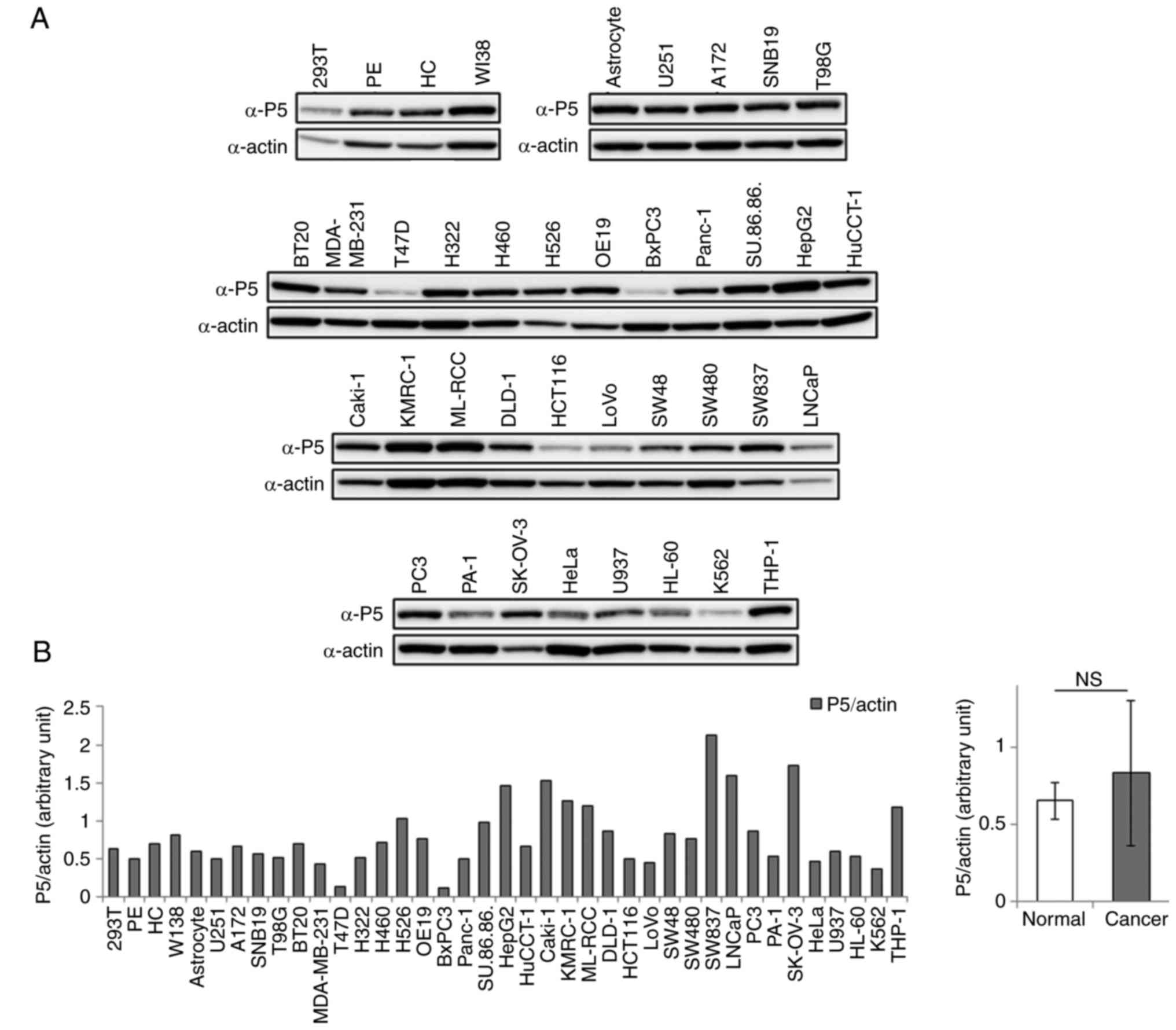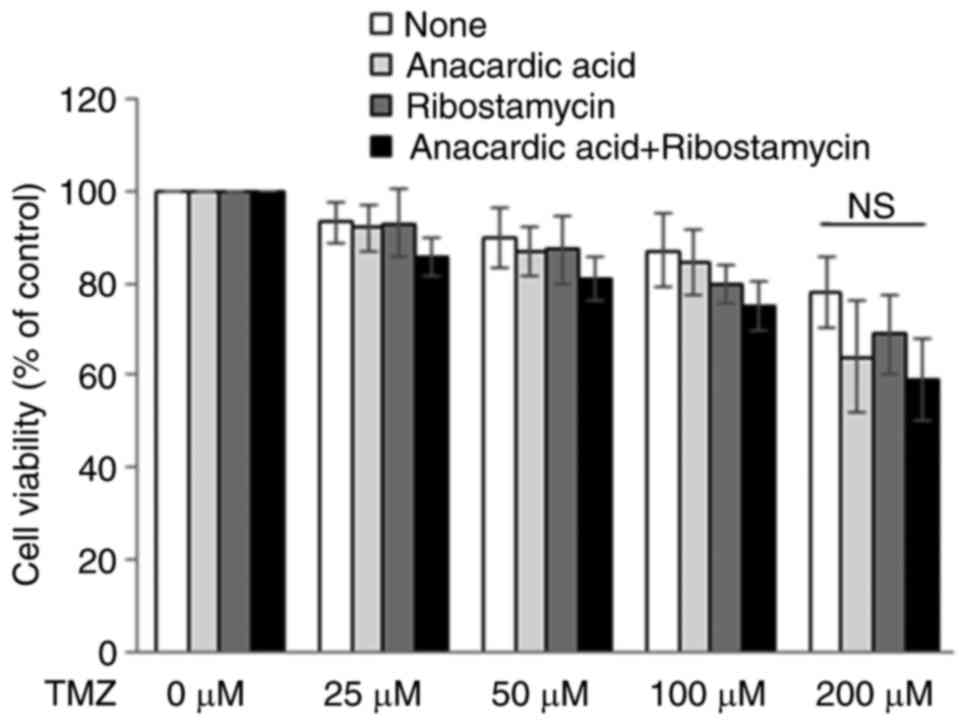|
1
|
Laurindo FR, Pescatore LA and Fernandes
Dde C: Protein disulfide isomerase in redox cell signaling and
homeostasis. Free Radic Biol Med. 52:1954–1969. 2012. View Article : Google Scholar : PubMed/NCBI
|
|
2
|
Galligan JJ and Petersen DR: The human
protein disulfide isomerase gene family. Hum Genomics. 6:62012.
View Article : Google Scholar : PubMed/NCBI
|
|
3
|
Kikuchi M, Doi E, Tsujimoto I, Horibe T
and Tsujimoto Y: Functional analysis of P5, a protein disulfide
isomerase homologue. J Biochem. 132:451–455. 2002. View Article : Google Scholar : PubMed/NCBI
|
|
4
|
Kaiser BK, Yim D, Chow IT, Gonzalez S, Dai
Z, Mann HH, Strong RK, Groh V and Spies T:
Disulphide-isomerase-enabled shedding of tumor-associated NKG2D
ligands. Nature. 447:482–486. 2007. View Article : Google Scholar : PubMed/NCBI
|
|
5
|
Kimura T, Horibe T, Sakamoto C, Shitara Y,
Fujiwara F, Komiya T, Yamamoto A, Hayano T, Takahashi N and Kikuchi
M: Evidence for mitochondrial localization of P5, a member of the
protein disulphide isomerase family. J Biochem. 144:187–196. 2008.
View Article : Google Scholar : PubMed/NCBI
|
|
6
|
Shitara Y, Tonohora Y, Goto T, Yamada Y,
Miki T, Makino H, Miwa M and Komiya T: Mitochondrial P5, a member
of protein disulphide isomerase family, suppresses oxidative
stress-induced cell death. J Biochem. 152:73–85. 2012. View Article : Google Scholar : PubMed/NCBI
|
|
7
|
Lovat PE, Corazzari M, Armstrong JL,
Martin S, Pagliarini V, Hill D, Brown AM, Piacentini M,
Birch-Machin MA and Redfern CP: Increasing melanoma cell death
using inhibitors of protein disulfide isomerases to abrogate
survival response to endoplasmic reticulum stress. Cancer Res.
68:5363–5369. 2008. View Article : Google Scholar : PubMed/NCBI
|
|
8
|
Bonome T, Levine DA, Shih J, Randonovich
M, Pise-Masison CA, Bogomolniy F, Ozbun L, Brady J, Barrett JC,
Boyd J, et al: A gene signature predicting for survival in
suboptimally debulked patients with ovarian cancer. Cancer Res.
68:5478–5486. 2008. View Article : Google Scholar : PubMed/NCBI
|
|
9
|
Talantov D, Mazumder A, Yu JX, Briggs T,
Jiang Y, Backus J, Atkins D and Wang Y: Novel genes associated with
malignant melanoma but not benign melanocytic lesions. Clin Cancer
Res. 11:7234–7242. 2005. View Article : Google Scholar : PubMed/NCBI
|
|
10
|
Xu S, Butkevich AN, Yamada R, Zhou Y,
Debnath B, Duncan R, Zandi E, Petasis NA and Neamati N: Discovery
of an orally active small-molecule irreversible inhibitor of
protein disulfide isomerase for ovarian cancer treatment. Proc Natl
Acad Sci USA. 109:16348–16353. 2012. View Article : Google Scholar : PubMed/NCBI
|
|
11
|
Horibe T, Torisawa A, Okuno Y and Kawakami
K: Discovery of protein disulfide isomerase P5 inhibitors that
reduce the secretion of MICA from cancer cells. ChemBioChem.
15:1599–1606. 2014. View Article : Google Scholar : PubMed/NCBI
|
|
12
|
Kimura T, Nishida A, Ohara N, Yamagishi D,
Horibe T and Kikuchi M: Functional analysis of the CXXC motif using
phage antibodies that cross-react with protein disulphide-isomerase
family proteins. Biochem J. 382:169–176. 2004. View Article : Google Scholar : PubMed/NCBI
|
|
13
|
Obiri NI, Hillman CG, Haas GP, Sud S and
Puri RK: Expression of high affinity interleukin-4 receptors on
human renal cell carcinoma cells and inhibition of tumor cell
growth in vitro by interleukin-4. J Clin Invest. 91:88–93. 1993.
View Article : Google Scholar : PubMed/NCBI
|
|
14
|
Kohno M, Horibe T, Ohara K, Ito S and
Kawakami K: The membrane-lytic peptide K8L9 and melittin enter
cancer cells via receptor endocytosis following subcytotoxic
exposure. Chem Biol. 21:1522–1532. 2014. View Article : Google Scholar : PubMed/NCBI
|
|
15
|
Kohno M, Horibe T, Haramoto M, Yano Y,
Ohara K, Nakajima O, Matsuzaki K and Kawakami K: A novel hybrid
peptide targeting EGFR-expressing cancers. Eur J Cancer.
47:773–783. 2011. View Article : Google Scholar : PubMed/NCBI
|
|
16
|
Honjo Y, Horibe T, Torisawa A, Ito H,
Nakanishi A, Mori H, Komiya T, Takahashi R and Kawakami K: Protein
disulfide isomerase P5-immunopositive inclusions in patients with
Alzheimer's disease. J Alzheimers Dis. 38:601–609. 2014. View Article : Google Scholar : PubMed/NCBI
|
|
17
|
MacLeod TJ, Kwon M, Filipenko NR and
Waisman DM: Phospholipid-associated annexin A2-S100A10
heterotetramer and its subunits: Characterization of the
interaction with tissue plasminogen activator, plasminogen, and
plasmin. J Biol Chem. 278:25577–25584. 2003. View Article : Google Scholar : PubMed/NCBI
|
|
18
|
Yang L, Horibe T, Kohno M, Haramoto M,
Ohara K and Kawakami K: Targeting interleukin-4 receptor α with
hybrid peptide for effective cancer therapy. Mol Cancer Ther.
11:235–243. 2012. View Article : Google Scholar : PubMed/NCBI
|
|
19
|
Horibe T, Okushima N, Torisawa A, Akiyoshi
R, Hatta-Ohashi Y, Suzuki H and Kawakami K: Evaluation of chemical
chaperones based on the monitoring of Bip promoter activity and
visualization of extracellular vesicles by real time
bioluminescence imaging. Luminescence. 33:249–255. 2018. View Article : Google Scholar : PubMed/NCBI
|
|
20
|
Subach OM, Patterson GH, Ting LM, Wang Y,
Condeelis JS and Verkhusha VV: A photoswitchable orange-to-far-red
fluorescent protein, PSmOrange. Nat Methods. 8:771–777. 2011.
View Article : Google Scholar : PubMed/NCBI
|
|
21
|
Lozzio CB and Lozzio BB: Human chronic
myelogenous leukemia cell-line with positive Philadelphia
chromosome. Blood. 45:321–334. 1975.PubMed/NCBI
|
|
22
|
Tsuchiya S, Yamabe M, Yamaguchi Y,
Kobayashi Y, Konno T and Tada K: Establishment and characterization
of a human acute monocytic leukemia cell line (THP-1). Int J
Cancer. 26:171–176. 1980. View Article : Google Scholar : PubMed/NCBI
|
|
23
|
Satelli A and Li S: Vimentin in cancer and
its potential as a molecular target for cancer therapy. Cell Mol
Life Sci. 68:3033–3046. 2011. View Article : Google Scholar : PubMed/NCBI
|
|
24
|
Mendez MG, Kojima S and Goldman RD:
Vimentin induces changes in cell shape, motility, and adhesion
during the epithelial to mesenchymal transition. FASEB J.
24:1838–1851. 2010. View Article : Google Scholar : PubMed/NCBI
|
|
25
|
Myung JK, Choi SA, Kim SK, Wang KC and
Park SH: Snail plays an oncogenic role in glioblastoma by promoting
epithelial mesenchymal transition. Int J Exp Pathol. 7:1977–1987.
2014.
|
|
26
|
Jhanwar-Uniyal M, Labagnara M, Friedman M,
Kwasnicki A and Murali R: Glioblastoma: Molecular pathways, stem
cells and therapeutic targets. Cancers. 7:538–555. 2015. View Article : Google Scholar : PubMed/NCBI
|
|
27
|
Horibe T, Torisawa A, Akiyoshi R,
Hatta-Ohashi Y, Suzuki H and Kawakami K: Transfection efficiency of
normal and cancer cell lines and monitoring of promoter activity by
single-cell bioluminescence imaging. Luminescence. 29:96–100. 2014.
View Article : Google Scholar : PubMed/NCBI
|
|
28
|
Turano C, Coppari S, Altieri F and Ferraro
A: Proteins of the PDI family: Unpredicted non-ER locations and
functions. J Cell Physiol. 193:154–163. 2002. View Article : Google Scholar : PubMed/NCBI
|
|
29
|
Barbouche R, Miquelis R, Jones IM and
Fenouillet E: Protein-disulfide isomerase-mediated reduction of two
disulfide bonds of HIV envelope glycoprotein 120 occurs post-CXCR4
binding and is required for fusion. J Biol Chem. 278:3131–3136.
2003. View Article : Google Scholar : PubMed/NCBI
|
|
30
|
Ryser HJ, Levy EM, Mandel R and DiSciullo
GJ: Inhibition of human immunodeficiency virus infection by agents
that interfere with thiol-disulfide interchange upon virus-receptor
interaction. Proc Natl Acad Sci USA. 91:4559–4563. 1994. View Article : Google Scholar : PubMed/NCBI
|
|
31
|
Tsai YL, Zhang Y, Tseng CC, Stanciauskas
R, Pinaud F and Lee AS: Characterization and mechanism of
stress-induced translocation of 78-kilodalton glucose-regulated
protein (GRP78) to the cell surface. J Biol Chem. 290:8049–8064.
2015. View Article : Google Scholar : PubMed/NCBI
|
|
32
|
Davenport EL, Morgan GJ and Davies FE:
Untangling the unfolded protein response. Cell Cycle. 7:865–869.
2008. View Article : Google Scholar : PubMed/NCBI
|
|
33
|
Schönthal AH: Pharmacological targeting of
endoplasmic reticulum stress signaling in cancer. Biochem
Pharmacol. 85:653–666. 2013. View Article : Google Scholar : PubMed/NCBI
|
|
34
|
Pyrko P, Schönthal AH, Hofman FM, Chen TC
and Lee AS: The unfolded protein response regulator GRP78/BiP as a
novel target for increasing chemosensitivity in malignant gliomas.
Cancer Res. 67:9809–9816. 2007. View Article : Google Scholar : PubMed/NCBI
|
|
35
|
Jessop CE, Watkins RH, Simmons JJ, Tasab M
and Bulleid NJ: Protein disulfide isomerase family members show
distinct substrate specificity: P5 is target to BiP client
proteins. J Cell Sci. 122:4287–4295. 2009. View Article : Google Scholar : PubMed/NCBI
|
|
36
|
Choy G, O'Connor S, Diehn FE, Costouros N,
Alexander HR, Choyke P and Libutti SK: Comparison of noninvasive
fluorescent and bioluminescent small animal optical imaging.
Biotechniques. 35:1022–1026. 2003. View Article : Google Scholar : PubMed/NCBI
|
|
37
|
Dixit R and Cyr R: Cell damage and
reactive oxygen species production induced by fluorescence
microscopy: Effect on mitosis and guidelines for non-invasive
fluorescence microscopy. Plant J. 36:280–290. 2003. View Article : Google Scholar : PubMed/NCBI
|
|
38
|
Strayer C, Oyama T, Schultz TF, Raman R,
Somers DE, Más P, Panda S, Kreps JA and Kay SA: Cloning of the
Arabidopsis clock gene TOC1, an autoregulatory response regulator
homolog. Science. 289:768–771. 2000. View Article : Google Scholar : PubMed/NCBI
|
|
39
|
Venur VA, Peereboom DM and Ahluwalia MS:
Current medical treatment of glioblastoma. Cancer Treat Res.
163:103–115. 2015. View Article : Google Scholar : PubMed/NCBI
|
|
40
|
Ko MK and Kay EP: PDI-mediated ER
retention and proteasomal degradation of procollagen I in corneal
endothelial cells. Exp Cell Res. 295:25–35. 2004. View Article : Google Scholar : PubMed/NCBI
|
















